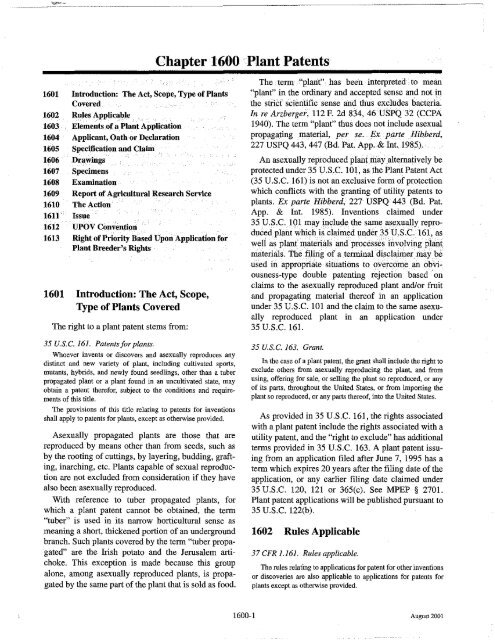The Subject Patent Already Has Underlining or ... - Bayhdolecentral
The Subject Patent Already Has Underlining or ... - Bayhdolecentral
The Subject Patent Already Has Underlining or ... - Bayhdolecentral
You also want an ePaper? Increase the reach of your titles
YUMPU automatically turns print PDFs into web optimized ePapers that Google loves.
1601<br />
1602<br />
1603<br />
1604<br />
1605<br />
1606<br />
1607<br />
1608<br />
1609<br />
1610<br />
1611<br />
1612<br />
1613<br />
1601<br />
Introduction: <strong>The</strong> Act, Scope, Type of Plants<br />
Covered<br />
Rll.les Applicable<br />
Elements.of aPlant Application<br />
Applicant, Oath <strong>or</strong> Declaration<br />
Specification and Claim<br />
Drawings<br />
Specimens<br />
Examination<br />
Rep<strong>or</strong>t of Agricultural Research Service<br />
<strong>The</strong> Actiou<br />
Issue<br />
UPOV Cou-,ention<br />
Right of Pri<strong>or</strong>ity Based Upon Application f<strong>or</strong><br />
Plaut Breeder's Rights<br />
Introduction: <strong>The</strong> Act, Scope,<br />
Type of Plants Covered<br />
<strong>The</strong> right to a plant patent stems from:<br />
35 U.S.c. 161. <strong>Patent</strong>sf<strong>or</strong> plants.<br />
Whoever invents <strong>or</strong> discovers and asexually reproduces any<br />
distinct and new variety of plant, including cultivated sp<strong>or</strong>ts,<br />
mutants, hybrids, and newly found seedlings, other than a tuber<br />
propagated plant <strong>or</strong> a plant found in an uncultivated state, may<br />
obtain a patent theref<strong>or</strong>, subject to the conditions and requirements<br />
of this title.<br />
<strong>The</strong> provisions of this title relating to patents f<strong>or</strong> inventions<br />
shall apply to patents f<strong>or</strong> plants, except as otherwise provided.<br />
Asexually propagated plants are those that are<br />
reproduced by means other than from seeds, such as<br />
by the rooting of cuttings, by layering, budding, grafting,<br />
inarching, etc. Plants capable of sexual reproduction<br />
are not excluded from consideration if they have<br />
also been asexually reproduced.<br />
With reference to tuber propagated plants, f<strong>or</strong><br />
which a plant patent cannot be obtained, the term<br />
"tuber" is used in its narrow h<strong>or</strong>ticultural sense as<br />
meaning a sh<strong>or</strong>t, thickened p<strong>or</strong>tion of an underground<br />
branch. Such plants covered by the term "tuber propagated"<br />
are the Irish potato and the Jerusalem artichoke.<br />
This exception is made because this group<br />
alone, among asexually reproduced plants, is propagated<br />
by the same part of the plant that is sold as food.<br />
Chapter·1600 Plant <strong>Patent</strong>s<br />
<strong>The</strong> term "plant" has been interpreted to mean<br />
"plant" in the <strong>or</strong>dinary and accepted sense and not in<br />
the strict scientific sense and thus excludes bacteria.<br />
In re Arzberger, 112 F. 2d 834, 46USPQ32 (CCPA<br />
1940). <strong>The</strong> term "plant" thus does not include asexual<br />
propagating material, per se. Ex parte Hibberd,<br />
227 USPQ 443,447 (Bd. Pat. App.& Int.J985).<br />
An asexually reproduced plantmay alternatively be<br />
protected under 35 U.S.C. lOl, as the Plant <strong>Patent</strong> Act<br />
(35 U.S.c. 161) is not an exclusive f<strong>or</strong>m of protection<br />
which conflicts with the granting of utility patents to<br />
plants. Ex parte Hibberd, 227 USPQ443 (Bd. Pat.<br />
App. & Int. 1985). Inventions claimed under<br />
35U.S.C.191 may include the same asexually reproducedplant<br />
Which is claimed under}? U.S.C-.161, as<br />
well as plant materials and processes involving plant<br />
materials, <strong>The</strong> filing of a terminal disclaimer.may be<br />
used in appropriate situations to overcome an obviousness-type<br />
double patenting rejection based on<br />
claims to the asexually reproduced plant and/<strong>or</strong> fruit<br />
and propagating material thereof in an application<br />
under 35 U.S.C. lOl and the claim to the same asexually<br />
reproduced plant in an application under<br />
35 U.S.C. 161.<br />
35 U.S.c. 163. Grant.<br />
In the case of a plant patent, the grant shall include the right to<br />
exclude others from asexually reproducing the plant, and from<br />
using, offering f<strong>or</strong> sale, <strong>or</strong> selling the plant so reproduced, <strong>or</strong> any<br />
of its parts, throughout the United States, <strong>or</strong> from imp<strong>or</strong>ting the<br />
plant so reproduced, <strong>or</strong> any parts thereof, into the United States.<br />
As provided in 35 U.S.C. 161, the rights associated<br />
with a plant patent include the rights associated with a<br />
utility patent, and the "right to exclude" has additional<br />
terms provided in 35 U.S.c. 163. A plant patent issuing<br />
from an application filed after June 7, 1995 has a<br />
term which expires 20 years after the filing date of the<br />
application, <strong>or</strong> any earlier filing date claimed under<br />
35 U.S.C. 120, 121 <strong>or</strong> 365(c). See MPEP § 2701.<br />
Plant patent applications will be published pursuant to<br />
35 U.S.c. 122(b).<br />
1602 Rules Applicable<br />
37 CFR 1.161. Rules applicable.<br />
<strong>The</strong>rules relatingto applications f<strong>or</strong> patentf<strong>or</strong> otherinventions<br />
<strong>or</strong> discoveries are also applicable to applications f<strong>or</strong> patents f<strong>or</strong><br />
plants except as otherwise provided.<br />
1600-1 August 2001

















